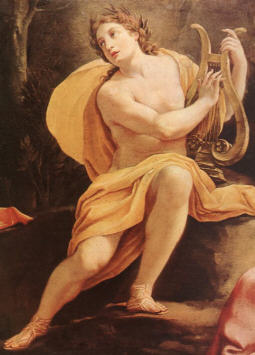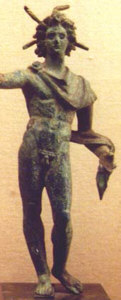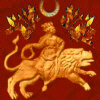





|
|
|
DELPHIC HYMN TO APOLLO Oh, come now, Muses, and go to the craggy sacred place upon the far-seen, twin-peaked Parnassus, celebrated and dear to us, Pierian maidens. Repose on the snow-clad mountain top; celebrate the Pythian Lord with the golden sword, Phoebus, whom Leto bore unassisted on the Delian rock. surrounded by silvery olives, the luxuriant plant which the Goddess Pallas long ago brought forth. --- transl.: Richard Hooker |

APOLLO QVAESO TE VT DES PACEM PROPITIVS
SALVTEM ET SANITATEM NOSTRAE FAMILIAE
--- Mercator, 678-679. |
|
Apollo, brother of Artemis (Diana) is hailed as Phoebus,
Musagetes (Leader of the Muses), Helios, and by many other
names and epithets in the Hellenic tradition. Apollo is
associated with the gift of prophecy to Delphic Pythia and
Sibyls alike. According to Livy, the first Roman Shrine of Apollo (AEDES APOLLONIS) was consecrated in 431 B.C.E. in the Prata Flaminia. The site had already been a sacred enclosure or grove associated with the God. Among the Italic peoples he was called SOL INDIGES (the Native Sun) and SOL INVICTVS (the Unconquered Sun), whose cultus became most prominent under Aurelian, a generation after the Roman Millennium. Aurelian dedicated a great temple to SOL INVICTVS in 274 C.E., on Rome's Campus Martius. In Syrian Emesa, the Solar Deity was known by the name Elah Gabal (God of the Mountain) and revered in the image of a sacred black meteoric stone. This icon was brought to Rome by the teenage emperor, Avitus Bassianus, who became known as Elagabalus through the name of the God, whom he considered to be a universal supreme deity. That notion was then quite alien to Roman Religion, though it was embraced by Constantine only a century later. That Constantine's patron deity was indeed of a Solar nature, is evidenced by the ultimate importance placed on Sunday (Dies Solis) observance, and 25 December, already celebrated as Dies Natalis Solis. Additonally, the cross motif was widely used by solar religions to represent the four quarters of the year. Hellenic observance honored Apollo on the seventh day of each month, often with offerings of bay (laurel). Another important Roman Festival, dedicated to SOL INDIGES, is 9 August (V*ID*AVG). The 28th of August (V*KAL*SEPT) is yet another, though shared with LVNA, an aspect of Diana/Artemis.
|

Art, above: Simon Vouet, detail from
This page maintained by:
Return to my main index
|
